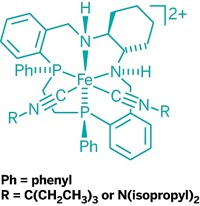Advertisement
Grab your lab coat. Let's get started
Welcome!
Welcome!
Create an account below to get 6 C&EN articles per month, receive newsletters and more - all free.
It seems this is your first time logging in online. Please enter the following information to continue.
As an ACS member you automatically get access to this site. All we need is few more details to create your reading experience.
Not you? Sign in with a different account.
Not you? Sign in with a different account.
ERROR 1
ERROR 1
ERROR 2
ERROR 2
ERROR 2
ERROR 2
ERROR 2
Password and Confirm password must match.
If you have an ACS member number, please enter it here so we can link this account to your membership. (optional)
ERROR 2
ACS values your privacy. By submitting your information, you are gaining access to C&EN and subscribing to our weekly newsletter. We use the information you provide to make your reading experience better, and we will never sell your data to third party members.
Synthesis
Companies At Informex Show What They've Got
by Ann M. Thayer
March 5, 2007
| A version of this story appeared in
Volume 85, Issue 10
The news at the recent Informex trade show in San Francisco included technology advances from custom chemical manufacturers. New bio- and chemocatalysts, as well as new organometallic and fluorinated reagents, were developments that stood out.
Through an alliance with the Danish industrial enzyme producer Novozymes, California-based Biocatalytics has started marketing NovoCat products. They include previously unavailable enzymes formulated for chemical synthesis and packaged for reaction screening. The first set contains 16 hydrolytic enzymes for chiral resolutions. Biocatalytics sells the biocatalysts and provides support from research through process development; Novozymes can supply production-scale quantities.
Similarly, Codexis is making its biocatalysts available for the first time outside the company in 96-well arrays called Codex panels. Customers pay an access fee and, by screening an array for reactivity, can evaluate if an enzymatic reaction is feasible. Codexis then offers further optimization and customization around successful hits.
Each one-time-use Codex panel includes enzymes designed to be robust, scalable, and tolerant of a range of substrates. The first panel contains about 300 ketoreductases for converting carbonyls to chiral alcohols.
BASF, meanwhile, promoted three proprietary epoxide hydrolases for making quaternary stereocenters and six new enoate reductases for selective asymmetric reductions that it uses in custom manufacturing. Both enzyme types offer high enantioselectivity under mild conditions, reported John Banger, head of new business development for BASF Intermediates.
As further evidence of the increasing importance of catalysis in chiral synthesis, Dowpharma's science and technology leader, Ian C. Lennon, described several asymmetric hydrogenations for producing metric-ton quantities of chiral products. Dowpharma makes rhodium and ruthenium catalysts in multikilogram amounts for these processes.
New phenyl phospholane ligands developed by the company are the subject of recent patent filings and scientific papers, Lennon noted. Among these is a 1,2-bis(2,5-diphenylphospholano)methane ligand proving useful in enantioselective hydrogenations (Tetrahedron Lett. 2007, 48, 1831).
Meanwhile, DSM Pharma Chemicals reported developments in biocatalysis and homogeneous catalysis. The company has constructed what it says may be the simplest possible catalyst for asymmetric hydrogenation. It's based on iridium and only one bulky phosphoramidite ligand (Angew. Chem. Int. Ed. 2007, 46, 1497).
To meet growing demand for specialized intermediates and building blocks, Halocarbon has increased production of trifluoroethylamine (TFEA) and is working to do the same for hexafluoroacetone derivatives. The company had been supplying hundreds-of-kilogram quantities of TFEA, explained Technical Director Barry Jones, but it has now developed a new high-volume process to meet a customer request for multiton quantities.
Fluorine also can be introduced into molecules with fluorinating agents. DuPont FluoroIntermediates says its new TFEDMA (N,N-dimethyl-1,1,2,2-tetrafluoroethylamine) is more stable and safer than many reagents and more fluorine-efficient than similar fluoroalkyl amino ones. It is useful for converting alcohols to alkyl fluorides, carboxylic acids to acyl fluorides, and sulfonic acids to sulfonyl fluorides. DuPont offers TFEDMA only on a research basis but will employ it in-house on behalf of larger volume customers.
To improve reagent handling and performance in other hazardous chemistries, Germany's Chemetall has joined with Penn Specialty Chemicals to market organometallic reagents, such as Grignard reagents, in 2-methyltetrahydrofuran (MeTHF). According to Penn, the solvent has chemical properties comparable with or better than THF's. Among these are the higher ability to dissolve Grignard reagents, increased reaction yields, and easier product recovery.
Read More
- UPSWING AHEAD
- An emerging biotech bonanza riveted contract manufacturers at Informex
- Informex Europe Debut Is Postponed
- Move to spring 2008 highlights competition in world of fine chemicals exhibitions
- Companies At Informex Show What They've Got





Join the conversation
Contact the reporter
Submit a Letter to the Editor for publication
Engage with us on Twitter